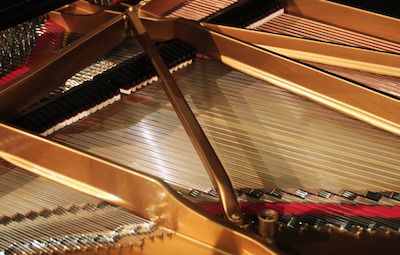Pianos are not guitars. Yet there seems to be a perception that piano strings are similar in nature, needing re-stringing from time to time.
Guitar strings are much thinner. They are in contact with oils and acids on a player’s fingers. That cuts into the life of a guitar string, requiring that new strings are put into place from time to time.
The piano is different. Strings are struck by hammers and buffered by compressed wool felt in between. They are also much thicker than guitar strings, and strung at a much higher tension.
When the tone of a piano begins faltering, it’s unlikely that it’s due to the quality of the strings. Piano strings should last for decades with normal usage. Other things might be wrong instead, including:
The hammers: Wear to the felt on the hammers substantially change over time. Reshaping and voicing worn felts can make a huge difference in tonal quality.
Soundboard: Pianos are made with a soundboard. The curvature, or crown, resists the downward push of the strings as they pass over the bridge. As a piano ages, the soundboard can flatten and lose the “springiness” that creates a rich sound. Replacement is the only answer when this wears out.
Action: Felt, leather, and cloth parts in the action can all wear out over time, creating mechanical sounds that dull the tone.
Bridges: Piano strings are secured at both ends as they pass over the soundboard and are connected at the bridges. Problems can occur at any point, with bearing bars, studs, holes, or other connection points.
When a piano reaches a point where the strings are in need of replacement, chances are a vast majority of the piano could use refurbishing too. While restringing may be the most labor intensive and complicated part of a restoration, it is a process that will breathe life back into a piano, and create and update something that will continue to give you enjoyment for decades to come.

